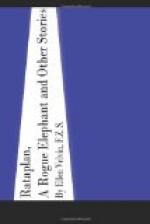A male buffalo is one of the most jealous things on the face of the earth, and his jealousy makes him quite mad for the time being. In a fight neither will give in until one kills the other, and so it was in Bulon’s case. He was determined to get the best of it, for he knew that, should the other buffalo kill him, the herd would probably select the conqueror as its leader in his place.
But, after a great clashing of horns, stamping of hoofs, and sharp snorts and grunts, Bulon’s opponent began to breathe heavily and show signs of distress, and when this took place the fight soon came to an end.
Bulon followed up his advantage with true buffalo skill, and in a very short time his enemy was in the dust and panting out his life. The fight once over, the herd moved on, leaving the dying buffalo by himself, for, in animal life, the old, sick or decrepit, are always treated with contempt.
Bulon led the way until they reached a nice, muddy swamp. The birds, however, having given warning of approaching danger, the males stationed themselves in an irregular circle in all the most dangerous positions—having first put the mothers and calves in the middle— while Bulon stood a little apart and kept his wicked little eyes first on the herd and then on the birds. He knew as well as the birds that an enemy was near, and but for this would have given the signal to feed. But the buffaloes were quite content; they were knee-deep in mud, surrounded by a thick, damp, hot mist, and as they were not particularly hungry, stood still and ruminated—that is to say, chewed their cuds and enjoyed themselves.
Having four stomachs, buffaloes’ food has the same process to go through as the food of all ruminants; that is to say, when vegetable matter is first eaten, it passes into the first stomach, where it stays until it is ready for the next one. The second stomach is much smaller, and covered with a number of curious little cells. After it has been in the second stomach for some time, and whenever the buffalo feels ready for it, the food comes back into the mouth, and he then bites or masticates it just as long as he likes. This is “chewing the cud.” When he has finished chewing the cud, the food goes into the third stomach, and after it has been there some time, it passes into the fourth one, where it is at last digested. So, although Bulon would not give the signal to feed, the buffaloes were quite happy, as they had plenty of food with which to chew the cud—an action which is invariably a sign of placid content among ruminants.
Bulon was the only one who was not ruminating. But then he was on the lookout for enemies, and, moreover, his temper was still exceedingly ruffled.
There were signs of a storm coming up; the air was quiet and still, and it was in this peculiar stillness that Bulon thought he heard an unusual sound in the bushes. He turned his huge head and sharp eyes in that direction, but in the next instant there was a short, sharp sound—a stinging, burning, pain in his shoulder and the old buffalo knew that he had been wounded.




